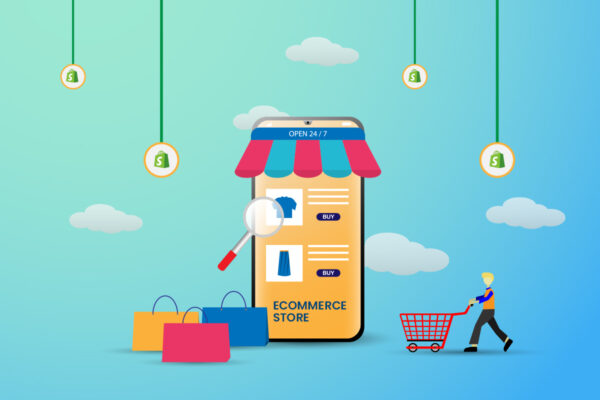Step Guide to Develop an Ecommerce Store on Shopify
Our shopping habits have changed in the digital age. Opening an online store is now easier and more profitable thanks to the growth of e-commerce. For those who are eager to enter the e-commerce space, Shopify is a top platform.
How then do you begin? These are the best six procedures for setting up a profitable Shopify online store.
Step 1: Plan Your E-commerce Business
Define Your Niche
First and foremost, determine what products you will be offering. Choosing the appropriate niche is vital. Your Your chosen specialty should complement your skills and areas of interest. Marketing goods you are knowledgeable about and passionate about is far easier.
Identify Your Target Market
Decide what things you will be selling first and foremost. Selecting the right niche is essential. Your chosen specialty should complement your skills and areas of interest. Marketing goods you are knowledgeable about and passionate about is far easier.
Determine Which Market to Aim for
Comprehending your product holds significance, yet understanding your customers is paramount. Delve into market research to grasp the needs, preferences, and obstacles confronting your target audience. Make better use of this information to target your target market with your marketing tactics and offers.
Step 2: Set Up Your Shopify Account
Signing Up
Create an account by visiting Shopify’s website. You may test out the platform with a 14-day free trial and an easy process.
Choosing the Right Plan
Shopify offers several pricing plans. As a beginner, the Basic Shopify plan is a good start, but assess your business needs and budget before deciding. Remember, you can always upgrade as your business grows.
Navigating the Dashboard
Once signed up, familiarize yourself with the Shopify dashboard. It is simple to operate, and you have ready access to all the necessary equipment. Spend some time exploring and getting acquainted with the configuration.
Step 3: Design Your Store
Selecting a Theme
Choose from a variety of themes that Shopify offers, including free and paid alternatives. Select a theme that will improve user experience while also showcasing the visual identity of your brand.
Customizing Your Theme
Adding unique touches to your store is essential to its success. Change typefaces, colors, and layouts to better represent your brand. You don’t need any prior coding skills to utilize Shopify’s theme editor because it is very easy to use.
Adding Branding Elements
Incorporate the hues, emblem, and distinctive traits of your brand. Consistency is paramount in fostering brand familiarity and earning your clients’ confidence.
Step 4: Add Products to Your Store
Creating Product Listings
Add your products by navigating to the “Products” section on the dashboard. Fill in all necessary details including product name, description, price, and images.
Organizing Products into Collections
Collections help customers find products easily. Group related products together (e.g., seasonal items, bestsellers) to enhance the shopping experience.
Writing Compelling Product Descriptions
Your product descriptions should be informative and engaging. Highlight the features and benefits, and include any important specifications. Use bullet points for clarity and SEO-friendly keywords to boost search visibility.
Step 5: Configure Essential Settings
Payment Gateways
Shopify accepts a number of payment methods, such as PayPal, credit cards, and more. Make sure your consumers have a simple and safe checkout experience.
Shipping Options
Set up your shipping rates and methods. You can offer free shipping, flat rates, or real-time carrier rates. Communicate your shipping policies to avoid any confusion.
Taxes and Legal Settings
Configure your tax settings according to your location and business structure. Shopify can automatically handle most tax calculations. Also, add legal pages such as privacy policy, terms of service, and return policy.
Step 6: Launch and Market Your Store
Pre-launch Checklist
Before going live, double-check everything. Test the checkout process, ensure all links work, and preview your store on different devices. Make sure your store looks great and functions flawlessly.
Marketing Strategies
After its launch, it’s crucial to effectively advertise your store. Employ a range of marketing channels such as social media, email campaigns, content marketing, and paid promotions to attract new customers. Enhance visibility and expand reach by partnering with influencers and implementing SEO strategies.
Analyzing Performance Metrics
Check the performance of your store with Shopify’s integrated analytics. Monitor important data including traffic, average order value, conversion rate, and client retention. Make wise decisions and maximize the performance of your store by using this data.
Conclusion
The process of creating a profitable e-commerce platform on Shopify is fulfilling. Plan your business plan, create an account, add products, modify critical settings, design your store’s appearance, launch, and promote your store are the six essential procedures you should follow. Partnering with the Best Startups Web Design Company can significantly enhance your store’s design and user experience.
With these steps mastered, your path to e-commerce triumph is paved. Don’t hesitate any longer—commence the journey of building your Shopify store today!



